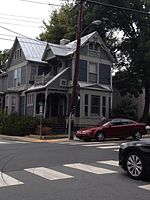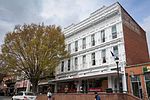George Rogers Clark Monument

The George Rogers Clark Monument was a historic monument consisting of multiple figures that was formerly located in Monument Square at Charlottesville, Virginia. Erected in November 1921, the monument consisted of seven figures, by the sculptor Robert Ingersoll Aitken, presented on the same pedestal. It was the last in a sequence of four works commissioned from members of the National Sculpture Society by philanthropist Paul Goodloe McIntire during the years 1919 to 1924. The sculpture was added to the National Register of Historic Places in 1997.The monument measured approximately 24 feet in height, 20 feet in length, and 8 feet in width. It included a tall bronze figure of George Rogers Clark mounted on a stallion in the center. The pedestal bore the inscription: "GEORGE ROGERS CLARK/ CONQUEROR OF THE NORTHWEST".The monument was removed by the University of Virginia on July 11, 2021. No immediate plan for what would be done with it was announced, although the university said it would consult with its students and members of the American Indian community of Charlottesville when deciding what to do with it.
Excerpt from the Wikipedia article George Rogers Clark Monument (License: CC BY-SA 3.0, Authors, Images).George Rogers Clark Monument
Lee Street, Charlottesville
Geographical coordinates (GPS) Address Phone number Website Nearby Places Show on map
Geographical coordinates (GPS)
| Latitude | Longitude |
|---|---|
| N 38.033055555556 ° | E -78.499166666667 ° |
Address
University of Virginia Medical Center
Lee Street 1215
22908 Charlottesville
Virginia, United States
Open on Google Maps








